The Story of 4 Yachts That Became the Ultimate Heirloom for These Seafaring Families

Marina Garghetti recalls many idyllic summer days aboard her family’s Baglietto, Solimar, but one in particular from the early 1970s stands out. “The sea of Tigullio was teeming with tuna,” she says. “My sporty mom had equipped the boat for deep-sea fishing, even though it wasn’t a fishing boat.” Garghetti, then in her early teens, and her two younger sisters headed out with their mom and the boat’s captain, while her father, Franco, was stuck in the office in Milan.
The captain piloted toward an off-shore fishing hole, so active the ocean’s surface boiled with the tunas’ feeding frenzy. “We caught fish after fish,” Garghetti says. “The tuna leaped out of the water when they took the bait, and we fought and fought to pull them in. It was such a thrilling day.”
More from Robb Report
Superyachts Are Showcasing More Digital Art Than Ever. Here's Why.
Meet the Minnesota Neighbors Who Own Some of the Country's Finest Vintage Boats
Inside This Caribbean Island's Decades-Long Saga to Become the Next Mustique
The mother and daughters landed so many tuna that seagulls followed them back to port, mistaking Solimar for a fishing trawler. At sunset, in a scene right out of a Fellini film, the family gave away the haul to local schools, restaurants and friends. “It was still a small seaside village then,” she says, “and we all knew each other.”
Solimar has been a fixture in the Santa Margherita Ligure port outside Genoa since the 59-foot vessel was delivered in 1973. The family took yearly summer-vacation cruises on the Mediterranean to Corsica, Sardinia, Elba and the Aeolian Islands. Garghetti, now in her sixties, recalls anchoring in coves, where the family slept onboard, visiting small fishing villages and enjoying sunsets all over Italy. “They were some of the happiest days of my life,” she says. “They brought a sense of cohesion to our family.”

Courtesy of Alessandro Mazzoni
So much so that Garghetti has kept the 49-year-old yacht in pristine condition, partly as a memory bank, partly because of her love of the sea, but mostly as a shrine to her parents, who instilled that love in her. Today it looks out of sync, almost like a relic, beside more modern vessels, but it’s as shipshape as when it was brand-new. Garghetti still goes out on Solimar nearly every summer day, and her daughter and her sisters’ children and grandchildren have all enjoyed vacations aboard. “The scent of the wood on the boat’s interior, the layout of the cabin, the cockpit where we’ve shared so many meals—they allow me to pass the experiences I had with my parents to my daughter,” she says. “Our story has been handed down from father to daughter, and I hope my daughter will love the boat as much as I do and pass it to her daughter.”
Yacht owners typically focus on the latest innovation, the next best thing, upgrading to ever-newer, larger vessels. But there are others—a tiny but passionate minority—who view their boats as heirlooms, similar to multigenerational summer homes, where the walls preserve precious memories. “These boats are not toys,” says Anselmo Vigani, a partner at RAM, a refit center on Italy’s Lake Iseo that maintains almost 100 vintage Rivas for owners. “It’s an object that reminds you of fun, happy moments. It’s the same boat you went on with your parents. It gives you the same feelings, even though it might be 50 years later. Most of our owners will never sell them.”
Summers on the Riviera
Jonathan Showering’s first memories of his family boat, La Mouette, remain as vivid now as when he was four years old in 1966. It was a gleaming mahogany Aquarama Super with burnt-sienna upholstery—a boat his parents bought to occupy their six children during summer holidays in Monaco. “It was the coolest thing I’d ever seen,” he recalls. “The lights in front were set into the hull like eyes, and the chrome bowsprit had a crocodile smile. You could always spot our Riva as it came around the headland.”
La Mouette, or “the Seagull” in English, was a standout, according to Showering, even among the beautiful wooden boats that filled the floating docks of Monte Carlo’s Port Hercules. The Aquarama was the icon of highly sought-after Rivas—floating fashion statements owned by Sophia Loren, Brigitte Bardot and King Hussein of Jordan, among other movie stars and royals—but the Showerings used it as a family runabout for waterskiing, day tripping to Saint-Tropez or just noodling around empty coves. “We have a picture of five of the six us waterskiing together behind the boat,” he says. “I think it bent the ski pole.”
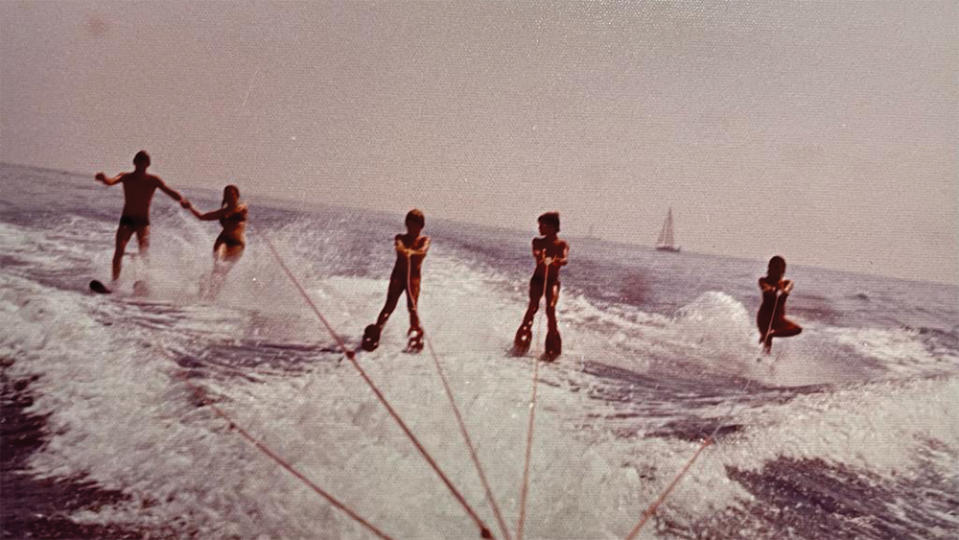
Courtesy of Jonathan Showering
“Joe the Boatman” was the family’s hired captain who took them on the day trips, with balmy nights on the water watching fireworks explode over the harbor. “When I was five, I was allowed to sit on Joe’s lap and steer the boat on my own for hours,” he says. “For years, I studied his every move like a hawk. I was 16 before my father let me drive.”
For Showering, whose family spent most of the year in the UK, where his father, Keith, served as chairman of the drinks company Allied Domecq, the summers became a blur of blissful, halcyon days that stretched into decades, a bonding—though he’d be loath to use that word—between siblings and parents. That’s quite a trick with six kids on a 27-foot boat, with a cockpit measuring 49 square feet. “I don’t recall any issues between us when we were on the boat,” he says. “We loved every second.”
Fifty-six years after embarking for the first time, Showering, 59, has not missed a summer aboard La Mouette. After his father died in 1982, the family held on to the vessel, and Showering, its most frequent captain, later gifted the Monaco experience to his wife, Emily, and four children. “We brought each child on the boat like Moses’s basket, soon after they were born,” he says. “They fell asleep immediately with the water’s motion and noise of the engines.” The kids have since grown up doing the same things he and his siblings did a half-century earlier.
The eldest, Eleanor, 29, has photos of herself onboard in her dad’s arms at about three months old, but her most vivid memories are of standing side by side with her siblings, Lily, Grace and James, on the passenger seat, holding on to the windshield, while her dad drove. “We’d do that everywhere we went,” she says. “We really used to enjoy it, jostling for position, until we got too big to stand next to each other. It’s what my father used to do as a child with Joe the Boatman.”
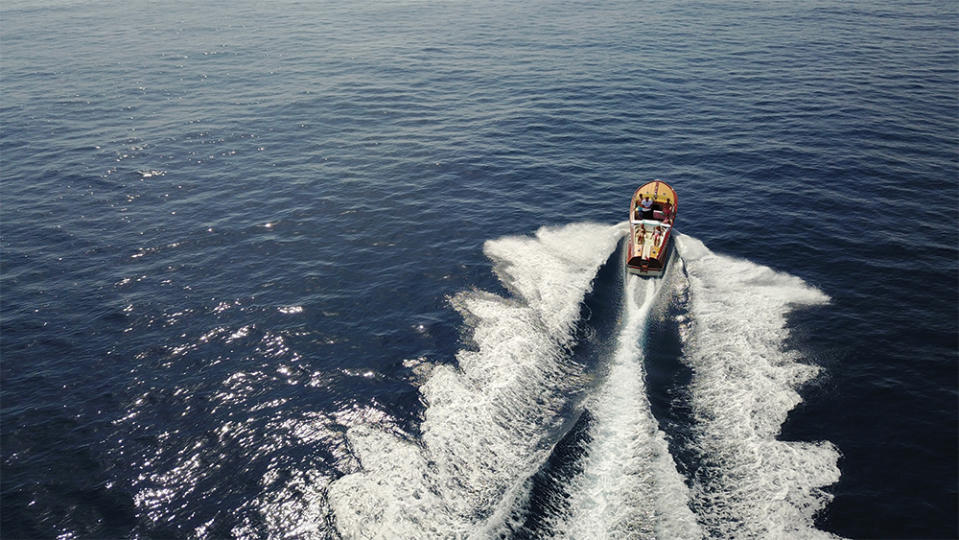
Courtesy of Jonathan Showering
Eleanor says part of La Mouette’s allure was connected to her father. “It was a special part of his childhood, so it felt special to us doing what he did on the boat and visiting the same places,” she says. “The boat almost feels like a living thing. We all have the same reverence for it.”
The kids all learned a routine to tie up the craft whenever they docked, a choreography that they follow to this day. Showering taught each child to pilot the boat when they came of driving age. They share his love for the boat’s tactile qualities—the smooth mahogany, the soft upholstery—as well as the throaty rumble of the V-8 engines.
“The days on La Mouette are my most special memories,” Eleanor says. “We never got bored. We’d go to Italy and France for lunch, arriving on this beautiful, glamorous boat. We were always very proud of it.” On other days, each child selected their favorite pastime. Eleanor enjoyed being the first boat in the Bay of Roquebrune, where the children would eat croissants and swim with fish. Grace reveled in waterskiing, Lily liked being pulled on the inflatable water toy, and James just loved to be at the helm. “My mother liked it best when we were lying and sunbathing quietly,” Eleanor adds.
There were also adventures: Four years ago, Showering, Emily, Eleanor and Lily took a wild ride from Monaco to Saint-Tropez in a race that is part of the Riva Trophy, the annual owners’ rally—against larger, modern, fiberglass Rivas. “My dad thought we had the best boat and wanted to win,” she says. The waves were so high La Mouette repeatedly went airborne. Eleanor was next to her father, reading the charts, while her sister and mother sat in the back. “We arrived completely soaked, salty and exhausted,” she says. “We managed to win but only got the prize for ‘Oldest Boat’ because our race number had fallen off the side. None of the other boats had any idea what we’d been through. They were just cruising along, sipping Champagne.”

Courtesy of Jonathan Showering
Now that everyone has a career, the summer holidays in Monaco are shorter, but the clan still spends three weeks there engaged in their beloved marine outings. Nobody has outgrown the La Mouette experience, and nobody expects to. “My children all want the boat,” says Showering. “They’ve never known a summer without it. They’d be devastated if it ever left the family.”
Arthur’s Boat
For the Wirtzes, a prominent name in Chicago, the 123-foot Feadship Blackhawk symbolizes the clan’s history. It’s also a 51-year-old living monument to the family patriarch, Arthur Wirtz, a real-estate and liquor mogul who bought the Chicago Blackhawks in 1954 and an ownership stake in the Bulls in 1972.
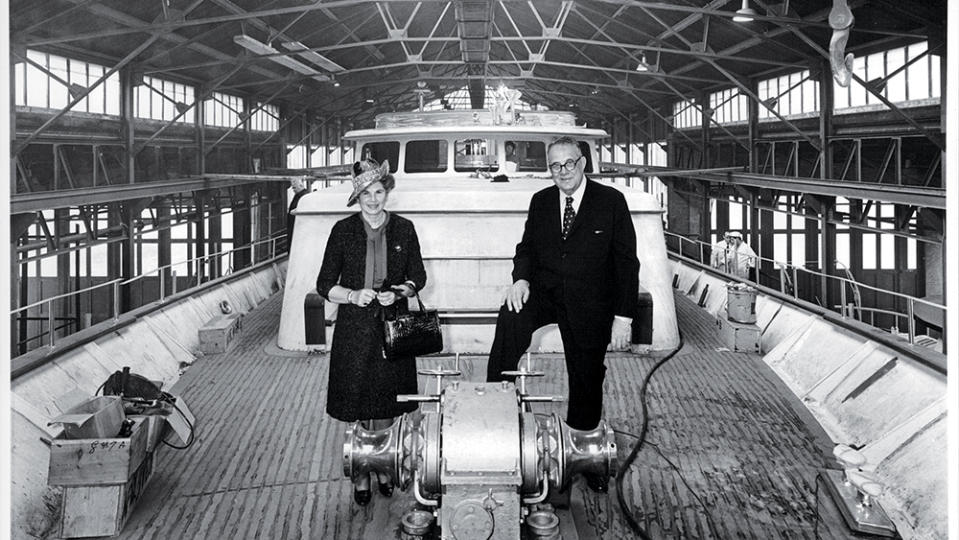
Courtesy of Feadship
While the sports teams brought Arthur fame, and the liquor business a fortune, the Feadship was his magnum opus. “He spent many hours designing that yacht after the office closed,” says William Rockwell “Rocky” Wirtz, Arthur’s grandson, president of the Wirtz Corp. and chairman of the Blackhawks. “He drew every square inch. When it launched in 1971, it changed the Feadship look for nearly a decade.”
Arthur’s last wishes specified that his heirs keep the boat, his wife Virginia’s 1961 Rolls-Royce and the family’s original land-grant farm from 1875 in Mundelein, Ill. “No mention of the Blackhawks or any of the other businesses,” says Wirtz. “Those three things he identified as his legacy. To him, they represented a man of humble means who was able to show he did well in the world.”
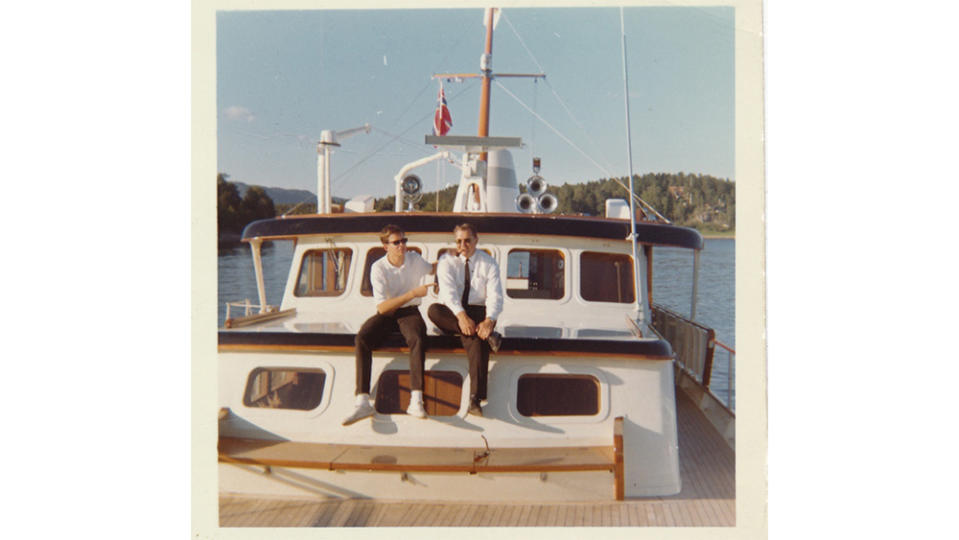
Courtesy of Feadship
Blackhawk was a novel design and, at the time, the world’s largest sportfishing boat. Arthur wanted to fish from the cockpit but have a formal dining room in the saloon for family time and business entertainment. (Arthur and Virginia befriended former President Lyndon B. Johnson and his wife, Claudia “Lady Bird” Johnson, taking them on tours of South Florida.) That combination of luxury and sportiness, though common in yachts now, was decades ahead of its time.
Today the interior looks almost the same as in 1983, when Arthur passed away: parquet floor in the dining room, mahogany paneling, sea-serpent fixtures in the head, floral artwork by Lê Pho personally chosen by Arthur for the four staterooms.
“He was a big man, six feet, five inches tall, who loved his air-conditioning,” says Wirtz, 69. “It still gets cold enough in there to hang meat.” The family has modernized many systems and employs a full-time crew of four to look after it in South Florida, but it remains Arthur’s boat.

Courtesy of Feadship
“It’s a time capsule—almost like walking into my great-grandparents’ home,” says Danny Wirtz, Rocky’s son and CEO of the Blackhawks. “We try to be unassuming, so even talking about us having a yacht makes me uncomfortable. We see it more as a family heirloom.”
Danny, 44, recalls the first time he was on the boat, in the early 1980s, when his grandfather Bill Wirtz took his children and grandchildren on a weeklong trip to the Exumas. “I was in complete awe, being able to eat, sleep and play on that amazing vessel,” he says. “Grandpa Bill would take us on these big adventures in the Whaler tenders, Power Play and Slap Shot—to diving holes, secret beaches, coral reefs. He was fearless—we’d go through storms, broken engines, getting lost.” But mostly he remembers Bill—Arthur’s son—adopting a new, happier persona on the boat. “He always wore a suit in Chicago,” Danny says. “But on the boat he was relaxed in his bathing suit—really in his element.”
Danny and his kids, Juniper and Rosemary, along with his sisters and their children, have continued the trips to the Exumas on Blackhawk and, more recently, cruised to Harbor Isle in the Bahamas. “It’s special that the fifth generation is able to experience it,” he says. “It’s the last touchpoint we have of Arthur.”
The First of a Famed Fleet
In the 1970s, Serafino Ferruzzi commissioned a yacht that would come to inspire one of the most storied pedigrees in racing. The Italian industrialist couldn’t even sail, but he wanted a fast boat for his son, Arturo, and son-in-law Raul Gardini. Il Moro di Venezia I, designed by Germán Frers, was one of the world’s most inventive racing sloops when it launched in 1976. It was a clever disrupter in the Italian Maxi Yacht class and progenitor of eight successive Il Moro di Venezias, including five America’s Cup competitors, each dreamed up for the clan by Frers to be ever faster and technically more sophisticated.
Serafino made a deal with the two younger men: If he bought the boat, they could race two weekends a month but would have to run the family’s agro-empire, Ferruzzi Finanziaria, for the other two. When it launched, Il Moro di Venezia I quickly morphed from a snappy reference both to Shakespeare’s Othello and two 15th-century giant bronze statues in Venice into a sailing legend: The yacht’s 92-foot mast towered high above others in the racing fleet. And it was fast, very fast, even in light winds.
“The boat was an experiment,” says Massimiliano “Max” Ferruzzi, Serafino’s grandson and the current owner. “It was long and elegant for its day, with that unusually large mast. It looked like a racing Ferrari in the harbor.”
Six years old when the boat was delivered, Ferruzzi, now 51, recalls its first, highly unusual shakedown cruise, a vessel’s first extended outing. “It was 10 p.m. and we were at dinner, and my father and his 20 friends decided to try the boat for the first time,” he says. “My cousin and I came with them, but we soon fell asleep in the cabin.”
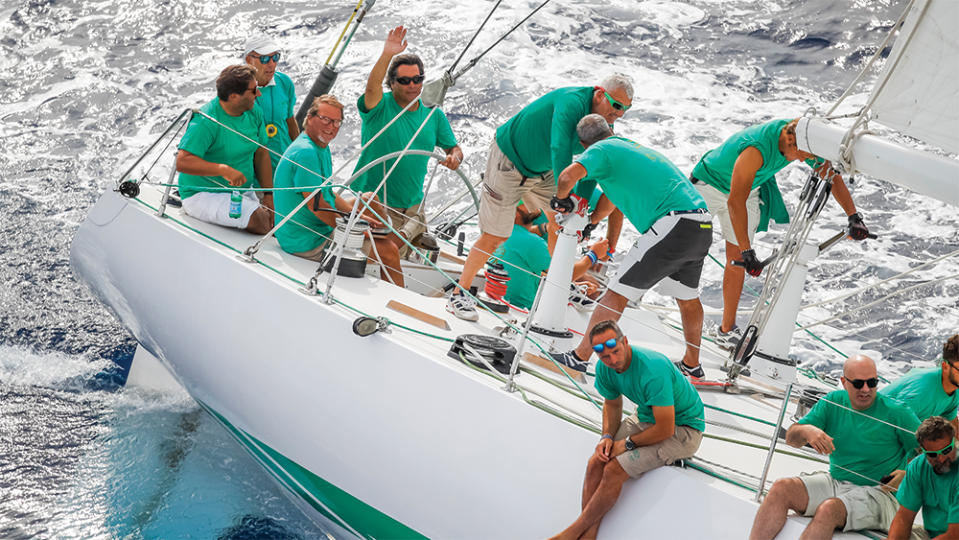
Courtesy of Max Ferruzzi
Come morning, instead of waking up in the harbor, they found themselves hundreds of miles away, sailing off the coast of Yugoslavia. “It became a 20-hour adventure—made more so because the captain, Angelo Vianello, had only stocked wine, no water,” Ferruzzi recalls. “There were no phones at that time, so my mother and aunt were worried sick. But we got home safely.”
Il Moro di Venezia I went on to win the 1977 Channel Race in the UK and the Miami-Nassau race the following year. In 1980, the brothers-in-law sold Il Moro di Venezia I after Il Moro di Venezia II was race-ready. That next-gen yacht soon began to win, too. “My uncle Raul always said never put too much passion into a boat, since a better one would always come along,” says Ferruzzi. “But my father was sentimental and felt like it was the family boat.” (Gardini later fell out with most of the clan and, amid a bribery investigation, died in 1993 in what was ruled a suicide.)
In all, Il Moro di Venezia had nine versions, each more modern and technical than the last, creating a legendary name in yacht racing. Angelo Vianello, whom Ferruzzi describes as a “naval genius,” was in charge of each one, up to the time of his death six years ago. The boats always used the most sophisticated materials available, constantly pushing the tech envelope for racing. One of the team’s legacies from the 1992 America’s Cup campaign was fast-tracking the growth of a number of suppliers, including B&G, Lewmar, Barient, Sparcraft, Navtec, and All Spars, which are now name brands in yachting.
In 1985, Arturo repurchased Il Moro di Venezia I and converted it into a cruiser. “He was done with racing,” says Ferruzzi. “It was too extreme for him.”
Ferruzzi himself had often crewed on the racing yachts but had never skippered one—that was a job, he thought, only for professional sailors. That attitude changed after Arturo gave him the vessel in 1996. Ferruzzi restored the boat to its former racing glory, with a new jib and rigging enhancements that made it even faster. In 2013, he began to compete in Maxi events and classic challenges, relying on 20 sailing friends as crew, rather than pros. Now at the helm, he loves the adrenaline surge of race starts, jockeying for position, reading the wind and figuring optimal strategies. “The situation’s always in flux, and you’re looking for solutions,” he says. “It’s intense and exciting, and I learn something new with every race.” While Max is the boat’s helmsman, longtime racing sailor Carlo Sessa is the captain who oversees every facet of the yacht.
The first Il Moro di Venezia was the season champion of the Panerai Classic Yachts Challenge for the Mediterranean circuit in 2013, 2015 and 2018 and has won 14 other Maxi races. “My father told me we’ve won more now than when Il Moro di Venezia I first launched,” says Ferruzzi.
His 18-year-old daughter, Emma, also loves the boat, serving as crew during races and going on month-long cruises with her father and her friends during the summer. “I always want this boat to stay in the family,” says Max. “At some point we may build Il Moro di Venezia X, but at this point, the original Il Moro di Venezia is enough.”
Best of Robb Report
Sign up for Robb Report's Newsletter. For the latest news, follow us on Facebook, Twitter, and Instagram.

